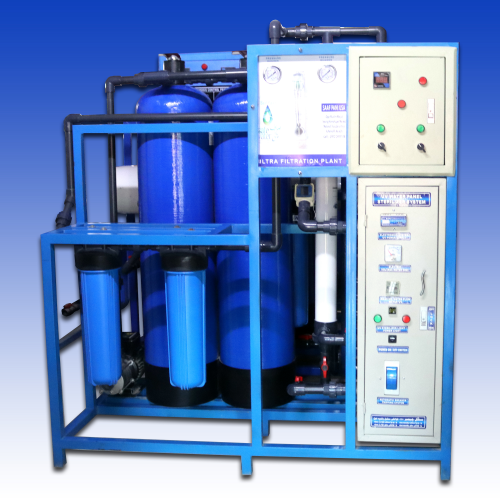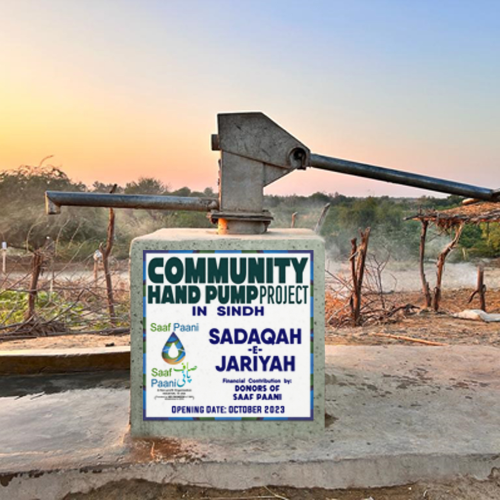Become a Sponsor. Get Involved.
Reverse Osmosis (R.O) Plant
Pakistan Council of Reseach in Water Resources (PCRWR) recommends the drinkable water should not exceed 1000 Total Dissolve Solids TDS. The sea water has a TDS of 35,000+ and the bottle water has a TDS of 250. Total dissolved solids (TDS) in water are the total concentration of inorganic and organic substances that can pass through a filter with pores of two microns in size. TDS in water are mostly made up of inorganic salts, such as calcium, magnesium, potassium, sodium, carbonates, nitrates, chlorides, and sulfates. In cases where the TDS exceeds TDS the only viable and commonly used method is to use Reverse Osmosis (R.O) plant. It is a sophisticated water treatment facility designed to purify water by removing impurities, contaminants, and dissolved minerals through the process of reverse osmosis. This technology utilizes a semi-permeable membrane to separate undesirable substances from water, producing clean and potable water. The process of reverse osmosis involves applying high pressure to the water by using a high-pressure pump, forcing it through a specialized membrane that allows only water molecules to pass while blocking the passage of impurities such as salts, minerals, bacteria, and other contaminants. This is possible due to the diameter of the membrane pores are so small that it lets the water molecule to pass through and rejects salt and other impurities molecule to pass through.The result is a purified water stream on one side of the membrane, while the rejected impurities are flushed away as concentrated brine. Reverse osmosis plants are widely used in various applications, including municipal water treatment, industrial processes, and desalination of seawater to make it suitable for human consumption and agricultural use. These plants play a crucial role in providing a sustainable and reliable source of high-quality drinking water in areas facing water scarcity or contamination challenges.
Ultrafilteration (U.F) Plant
Pakistan Council of Reseach in Water Resources (PCRWR) recommends the drinkable water should not exceed 1000 Total Dissolve Solids TDS. PCRWR recommends the use of Ultrafilteration (U.F) plant where the water is muddy, turbit but unsalty. Ultrafilteration technology is a water treatment facility that utilizes the process of Ultrafilteration to purify water. Ultrafilteration is a membrane-based technology that employs a semi-permeable membrane with fine pores to separate suspended solids, bacteria, and macromolecules from water. The membrane allows water molecules to pass through while blocking larger particles, contaminants, and microorganisms. In an Ultrafilteration Plant, water is pushed through the membrane under pressure, effectively sieving out impurities and producing a purified water stream. This technology is particularly effective in removing bacteria, viruses, colloidal matter, and other suspended solids. UF plants are commonly used for water treatment in various applications, including drinking water purification, wastewater treatment, and industrial processes. The advantages of Ultrafilteration include its ability to provide high-quality water without the use of chemicals, energy efficiency, and the removal of a wide range of contaminants. UF plants play a vital role in ensuring access to clean and safe water for both domestic and industrial purposes, contributing to improved water quality and environmental sustainability.
Solarized Submersible Pump
A solarized Submersible Pump is a water pumping system that integrates solar energy to power a Submersible Pump submerged in a water source, such as a well or borehole. This sustainable technology utilizes solar panels, having workable life of 25 years, to capture sunlight and convert it into electrical energy. The generated power is then used to drive the Submersible Pump, which is designed to be submerged below the water surface. The Submersible Pump draws water from the source and delivers it to the storage tank for various applications, such as safe drinking water to community, irrigation, or livestock watering. The solarized system is advantageous in areas with abundant sunlight and limited access to grid electricity. It offers a clean and renewable energy solution, reducing dependency on traditional power sources and minimizing environmental impact. Additionally, solarized Submersible Pumps contribute to water sustainability by providing an energy-efficient and cost-effective means of extracting water from underground sources. In areas of Sindh such as Achro Thar mostly it is a desert area where there are no paved roads, no milestone markers and no road signs and extremely difficult to locate villages, where the women folks have to walk an average of 3.7 miles to fetch two containers of water. Saaf Paani is providing 15 + Submersible Pumps per month in such villages where there are 10 to 15 homes so the women folks save time and take care of their children.
Community Hand Pump
A community Hand Pump is a water extraction device designed to serve the water needs of a community or a group of households. Typically installed near a water source such as a well or borehole, this Hand Pump is manually operated, allowing community members to draw water collectively. The pump usually consists of a vertical pipe with a handle and piston mechanism. Users rotate the handle to lift the piston, creating a suction that brings water from the underground source to the surface. Community Hand Pumps are a practical and cost-effective solution for providing reliable access to clean water in areas where infrastructure may be limited, fostering communal water-sharing practices. . This type of Hand Pump is characterized by its construction to draw water from depths which is typically up to 100 feet.
Shallow Hand Pump
A shallow Hand Pump is a simple and manually operated device designed for extracting water from shallow groundwater sources, typically found in wells or boreholes. This type of Hand Pump is characterized by its construction to draw water from relatively shallow depths, typically less than 50 feet. The pump consists of a vertical pipe with a piston and a handle. The user operates the handle manually, causing the piston to move up and down within the pipe. As the piston moves upward, it creates a vacuum that lifts water from the shallow underground source and into the pipe. When the handle is pushed down, the water is forced up and out of the pump for collection. Shallow Hand Pumps are commonly used in rural and remote areas, especially in regions where access to electricity is limited or unreliable. They provide a cost-effective and sustainable means of obtaining water for domestic use, irrigation, and livestock. These Hand Pumps are relatively easy to install and maintain, making them a practical and efficient solution for communities that rely on shallow groundwater sources.




